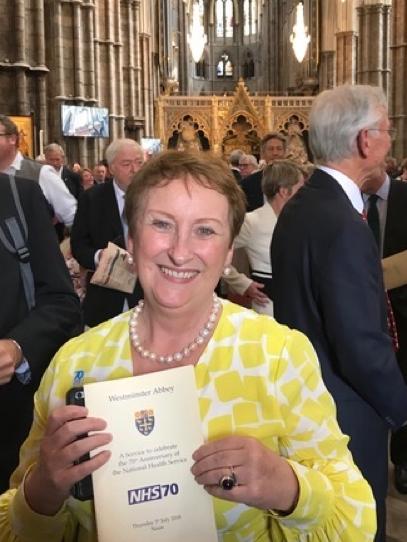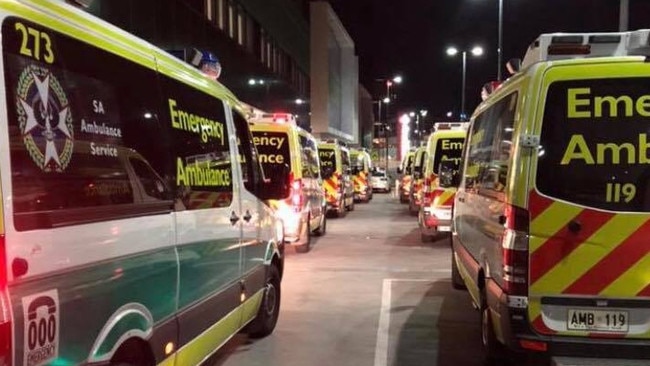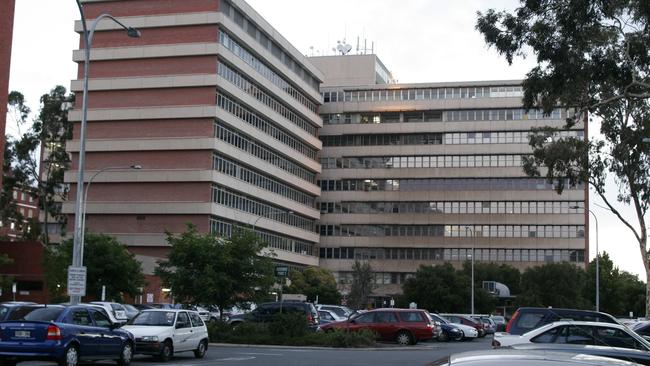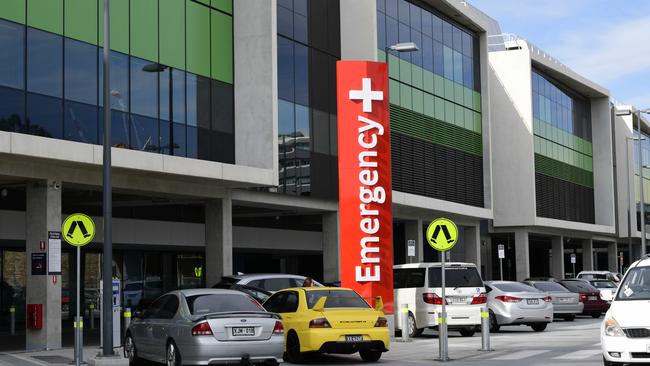New boss of Central Adelaide Local Health Network Lesley Dwyer on how she’ll tackle budget blowout and inefficiency
She has a huge, thankless task — the new boss of the Adelaide health network starts Monday, dealing with a $300m budget blowout and looming cost-cutting. Lesley Dwyer says the attitude of operating without repercussions “must stop now”.
SA News
Don't miss out on the headlines from SA News. Followed categories will be added to My News.
- True cost of Adelaide’s health network inefficiency
- Central Adelaide health network’s financial woes first flagged in 2012
- Record ramping as 18 ambulances stuck in RAH carpark
- $112m in health spending wasn’t properly approved
The new chief who takes charge of the Central Adelaide Local Health Network will “draw a line in the sand” on cultural change and intends “tapping into a global motivational movement” to help fix its financial woes.
Nurse, administrator, and grandmother Lesley Dwyer has run the huge Medway National Health Service Trust in Britain for three years – and is credited with a dramatic turnaround in its credentials.
Ms Dwyer takes up the job as consultants KordaMentha prepare to deliver their report into the networks’s ballooning budget deficit – heading towards $300 million this year – which is expected to recommend big cutbacks.
She saidshe would deal with the network’s budget dramas and its culture of overspending, but without compromising patient care.
But she bluntly noted there is a need for cultural changes in the bureaucracy.
“It’s clear there are enormous challenges ahead. I think history sends the message that the Network can operate inefficiently, without any repercussions and that attitude must stop right now,” he said.
“There is a line in the sand to be drawn. I do agree that it will be necessary to change some long entrenched attitudes within the network, but I am up to the challenge.”
She said she had established an attitude of ‘If not us, then who?’ at Medway which had become an unofficial staff motto.
“We have also recently tapped into global motivational movement ‘You are the difference’, which has had an incredible impact and I intend to bring those programs with me, in some form, to CALHN.
“Having a background in nursing, I really empathise with my staff and regularly go on what I call a “Gemba walk” visiting the wards – this includes all shifts day and night – observing the care and understanding what the reality is for our staff is absolutely essential.”
CALHN runs the $2.4 billion Royal Adelaide Hospital, the Queen Elizabeth Hospital and a host of statewide services including several facing privatisation. Ms Dwyer has been kept informed of plans to overhaul the network’s finances and believes significant changes can be made without cutbacks affecting patient care.
“Patient care is the reason our organisation exists and I intend to put our patients at the very centre of everything we will do,” she said.
“I firmly believe that addressing overspending on inefficient services and things that do not add value will drive better patient care and lead to a far better patient experience.
“There is strong international evidence that quality services not only provide better quality and better patient outcomes but also are cost effective.”
Read the full Q&A
What are your key priorities on taking up the role as chief executive in CALHN?
My priorities now and always will be the health and wellbeing of the patients who come through our doors and the people who work across all our sites.
In my view, restoring financial sustainability will be a key part of ensuring that we run an efficient and safe service for all South Australians, and ultimately provide world-class care.

Does your experience in Britain at MedWay (a hospital trust) help you with this challenge?
Absolutely. There’s no doubt in my mind that the challenges at CALHN can be overcome, because I have seen it happen first-hand at Medway.
When I started there in 2015, the organisation had been under special measures for two years because of a high mortality rate. I don’t believe it could have been a more difficult situation, with low morale and a lack of direction.
Through a collective focus, ensuring that we had the right leaders in place and hard work and persistence, we exited (the) special measures (the status the hospital at Medway had been under due it its previously poor management) in 2017, which remains one of my proudest moments.
The achievement was the culmination of a whole-of-hospital focus on safety; there was a lot of hard work that led to us improving, and it was a real indication that we were finally an organisation that our staff and our community could have confidence in and be proud of.
Medway is now recognised as being a safer, better place for patients and staff, and I feel my legacy is one of renewed confidence and ambition among the staff.
This experience was both humbling and enlightening for me, but was by no means through my efforts alone.
There were plenty of roadblocks, and I could not have navigated such significant change without a supportive team who were with me every step of the way.
In the end, my biggest learning was that empowering staff to make confident and informed decisions ultimately results in better outcomes for patients.

Is there any trepidation coming in as KordaMentha reviews the budget deficit, and their likely recommendations?
With any new job, there is always a sense of trepidation and anticipation, but I welcome the report.
I look forward to working with the implementation team and the CALHN staff to put the recommendations into action and drive CALHN to achieve its full potential.
How can you improve the efficiency of CALHN with regard to spending?
It’s clear there are enormous challenges ahead. I think history sends the message that the Network can operate inefficiently without any repercussions, and that attitude must stop right now. There is a line in the sand to be drawn.
Getting spending under control means finding the most efficient, safe and effective ways of providing services which will naturally result in better outcomes both financially and from a patient care perspective.
But one of the things that I won’t do is stifle innovation. We must continue to innovate and motivate people to give the best patient care in the most efficient way. I know that this makes a difference in an organisation that is looking to do things differently, and we’ll always support doing “the right thing”.
Do CALHN’s own staff have the expertise to rein in the deficit?
From the outside, it’s hard to know exactly what has led to this position, but I have no doubt there are really hardworking, exceptional staff across the Network. I found that this was true at Medway — the right people will always be there. As CEO, my role is to find them and support them to step forward.
I have been kept informed on the Turnaround project and I value having the external expertise involved. However, at the same time, you have to invest in staff to drive the change forward.
It appears KordaMentha’s recommendations may be implemented by an outside firm — how will you manage a health service when its finances are being run by an outside contractor?

I’ll await that decision before making any comment at this stage. However, it will take all of us working together to ensure that we all commit to delivering on the recommendations.
Patterns of overspending in CALHN have been described as a cultural issue which may take years to change. Do you agree? How will you change this culture?
I do agree that it will be necessary to change some long entrenched attitudes within the network, but I am up to the challenge.
I mentioned before that I have seen this happen at Medway and been part of that change, so I know it is possible.
At Medway, I’ve been successful in establishing the attitude “If not us, then who?” which has become an unofficial motto for our staff.
We have also recently tapped into global motivational movement “You are the difference”, which has had an incredible impact and I intend to bring those programs with me, in some form, to CALHN.
Having a background in nursing, I really empathise with my staff and regularly go on what I call a “Gemba walk” visiting the wards — this includes all shifts day and night — observing the care and understanding what the reality is for our staff is absolutely essential.
The senior leaders in CALHN being visible and supporting staff through what will be a really challenging time will be something that will be part of the change.
As a previous member of the CALHN executive, 2008-2011, were you part of this cultural problem? And if so how can you be part of the solution?
CALHN was created post my leaving SA but I still know each hospital and service. Having had that experience and then worked as part of several other healthcare services and witnessed incredible cultural change in very difficult circumstances, I have every confidence that it is possible at CALHN.

Is it possible to rein in the spending without compromising patient care?
Patient care is the reason our organisation exists and I intend to put our patients at the very centre of everything we will do at CALHN.
I firmly believe that addressing overspending on inefficient services and things that do not add value will drive better patient care and lead to a far better patient experience.
There is strong international evidence that quality services not only provide better quality and better patient outcomes but also are cost effective.
How would you characterise the QEH in relation to the RAH — is it an assistant hospital, an equal?
I understand that the Single Service Multi Site model that currently operates between TQEH and the RAH is a complimentary model that supports care delivery on both sites. Clearly there will be a need to look at whether this model is the best way forward but this will be done with staff taking into account the best way to deliver on the recommendations.
What is your view on outsourcing some of the statewide services which fall under CALHN’s control eg SA Pathology services, as has been suggested by the Treasurer?
I have seen different configurations in both the UK and in Australia — both useful in the correct context. That said, I understand there is a review underway into the specific case for South Australia and I will await the outcome of that review before I comment further.
How do you intend to address the chronic gridlock in the RAH emergency department?
There is no quick fix for any of the issues at CALHN but I am confident that the hospital can and will run efficiently. Addressing issues of hospital flow will be critical to addressing the “gridlock”, as you have called it.



